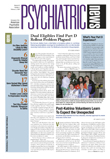Interpersonal violence, especially violence experienced by children, is the largest single preventable cause of mental illness. What cigarette smoking is to the rest of medicine, early childhood violence is to psychiatry. Writing in the April 22, 2005, Science, Frank Putnam and colleagues summarized the estimated prevalence of childhood sexual abuse and the association between childhood sexual abuse and serious mental and physical health problems, including substance abuse, and criminality in adulthood.
It is estimated that more than one-third of the U.S. population may have suffered a serious interpersonal trauma such as crime victimization, physical or sexual abuse, or assault. As much as 15 percent of the general population may have suffered multiple traumatic violent events, frequently beginning in early childhood. High-risk groups, such as inner-city youth, have even higher rates of trauma related to poverty, frequent violent crime, family dysfunction, and pervasive substance abuse.
Current estimates of posttraumatic stress disorder (PTSD) in the United States make it among the most common psychiatric disorders, but violence transcends PTSD. In children and adolescents, interpersonal violence is the leading risk factor for psychiatric hospitalization.
Interpersonal violence is also the major risk factor for a host of other serious problems among youth, including running away, conduct disorders, high-risk sexual behaviors, early pregnancy, suicidal behaviors, depression, and substance abuse. Research documents the biological effects of early trauma on brain development, intelligence, and neuroendocrine systems, which contribute to the severe behavior problems in childhood, as well as later in life.
Long-term health outcomes of childhood abuse are also highly adverse. Writing in the October 2003 General Internal Medicine, Springer and colleagues demonstrate that a variety of somatic symptoms is consistently found to be higher in adults with a history of physical abuse compared with those without an abuse history; these somatic symptoms include back pain, nightmares, fatigue, and other pain syndromes. The mental health effects of abuse are also well established and include a strong link to depression.
The lifetime prevalence of major depression in women with a history of childhood abuse is about three to five times greater than in women without such a history. In addition to depression, there is a higher incidence of anxiety disorders and personality disorders, especially borderline personality disorder, associated with a history of childhood abuse. Compared with other prevalent health problems, child maltreatment has been the focus of limited federal research funding. One recent positive development is the creation of the National Child Traumatic Stress Network, which is looking at the impact of trauma in a federally funded network of 54 sites providing community-based treatment for children and their families exposed to a wide range of trauma.
I have decided to appoint a special component—the Presidential Task Force on the Biopsychosocial Consequences of Early Childhood Violence—cochaired by former APA President Paul J. Fink, M.D., and Richard Loewenstein, M.D. This task force will bring together clinicians, researchers, public policy advocates, and others with relevant expertise to develop an integrative strategy for the prevention and treatment of violence and trauma-related disorders. The task force will review relevant research, epidemiology, demography, best practices, and theoretical formulations regarding prevention and interventions to decrease interpersonal violence.
My hope is that the task force will develop a series of action steps to inform clinical care and treatment, future research, parenting and family concerns, and community strategies. This task force will also look at the need for better education of psychiatrists and mental health professionals with an emphasis on trauma and trauma-related affective disorders as part of the routine history and differential diagnosis of psychiatric patients.
I have asked the task force to maintain a biopsychosocial approach throughout its deliberations to provide and integrate understanding of the many factors that lead to poor outcome, as well as to the relative resilience in trauma survivors. The task force will have two meetings in the coming months, and I expect its report by the May annual meeting in Toronto.▪

